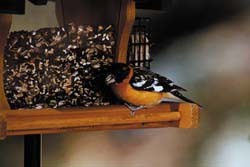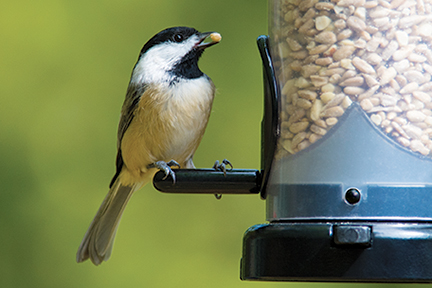
BIRD OF THE MONTH: BLACK-HEADED GROSBEAKS
In western North America in spring and summer, a sweet lilting song drifts down from the tree-tops sounding somewhat like a robin that has had a little too much to drink! It's the beautiful warble of a Black-headed Grosbeak.
Black-headed Grosbeak males are rich orange-cinnamon with a black head and black and white wings. Females and immature males are brown above with warm orange or buff on the breast. Some have streaks on the sides of the breast. In flight, bright yellow flashes under the wings. A hefty songbird, Black-headed Grosbeaks have very big, grayish bills. Their heads are also large and their necks, short and thick.
Black-headed Grosbeaks hop about in dense foliage gleaning insects and seeds. A combination of large trees and rich understory seems to be the ideal habitat.
Black-headed Grosbeaks' massive bills make them well equipped for cracking seeds, but those beaks are just as useful for snatching and crushing insects or snails. Beetles, spiders and other insects and animals make up about 60% of their breeding-season food. Fruits and seeds make up the rest. They will feed readily on sunflower seeds at feeders.
After spring migration, male and female Black-headed Grosbeaks form tight-knit pairs. Males court females with vigorous singing and striking displays called "nuptial flights" lasting 8 to 10 seconds. The male will flutter up from a perch, singing and spreading his wings and tail to reveal the bold white-on-black patterns. He will rise several feet into the air before settling back down on the same perch.
Black-headed Grosbeaks choose a nesting site in the outer branches of a deciduous tree or bush near a stream. The height of the placement is usually 25 feet or less. The female constructs the nest using slim twigs, stems, rootlets and pine needles. She lines it with finer stems, rootlets, hair, string and green material. The construction is very loose which may provide ventilation for keeping the nest and eggs cool.
The female will lay 2 - 5 eggs that are pale to greenish blue and speckled with brown or reddish brown. The eggs will be incubated for 12 - 14 days. The chicks are hatched helpless, eyes closed and nearly naked with sparse grayish white down on apricot skin. They will fledge in 10 - 14 days.
Both mom and dad sing on the nest, sit on the eggs and feed the young.
Here are some other cool, fun facts about Black-headed Grosbeaks:
The nests of Black-headed Grosbeaks are so thinly constructed that eggs often can be seen from below through the nest.
Black-headed Grosbeaks' huge beaks allow them to eat large grasshoppers, crickets and other insects that have tough exoskeletons.
By singing a "male" song, the female Black-headed Grosbeak can trick her mate into thinking a rival male is nearby, forcing him to stay closer to the nest. Her song is generally a simplified version of the male's.
Black-headed Grosbeaks are one of the few birds capable of eating toxic monarch butterflies. They discard the wings before eating the butterfly in an apparent attempt to reduce the amount of toxins they ingest.
Black-headed Grosbeaks have been known to feed at oriole nectar feeders.
The male Black-headed Grosbeak does not get its adult breeding plumage until it is two years old.
The Black-headed Grosbeak's species name, melanocephalus, mean "black-headed". Its genus name, Pheucticus, refers either to the Greek pheuticus for "shy" or phycticus meaning "painted with cosmetics".
The oldest known Black-headed Grosbeak was a male, at least 11 years, 11 months old, recaptured and rereleased in Montana.

